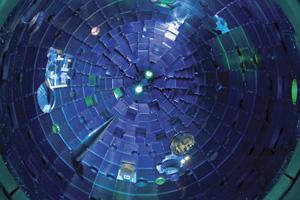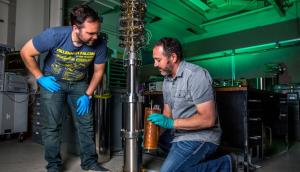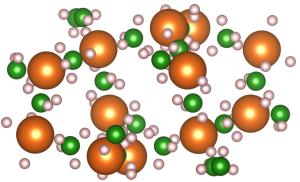LAB REPORT
Science and Technology Making Headlines
Oct. 16, 2015


The NIF Target Bay. NIF’s 192 laser beams converge at the center of this giant sphere to make the tiny hydrogen fuel pellet implode. Credit: Damien Jemison
NIF finds a place in the sun
Fusion, the process that powers the sun and the stars, has the ability to produce a commercially viable cheap, safe, clean, virtually limitless, sustainable fuel source.
Livermore is on the cutting edge of this research at the National Ignition Facility. NIF is the world’s largest, most powerful laser and scientists are working on a process called inertial confinement fusion.
You take a pellet filled with deuterium and tritium gas and place it inside a gold plated cylinder. Then you shoot it with intense laser light. The light heats the inner walls of the cylinder, creating a superhot plasma that showers the pellet with soft X-rays. The X-rays heat the outer surface of the pellet, causing it to implode. The implosion compresses and ignites the plasma and burns the fuel, causing a fusion reaction. The ultimate goal is to get more energy out of the process than is put in to power it.

Lawrence Livermore researchers have come up with a method called capacitive deionisation that removes salt from seawater.
Water worth its salt
Oceans cover more than 70 percent of the earth's surface and contain 97 percent of its water. But the energy needed to turn that salt water into drinking water is costly.
Now, thanks to new technologies, costs have been halved and huge desalination plants are opening around the world.
One of those methods is capacitive deionisation - essentially a magnet for salt. Michael Stadermann of Lawrence Livermore National Laboratory believes “we should be able to do brackish water desalination at between half and a fifth of the energy of reverse osmosis.”


Observations have provided hints that the dark matter around one of the central four merging galaxies is not moving with the galaxy itself.
Searching for dark matter
Dark matter is the invisible stuff that makes up a quarter of the universe, and 85 percent of all matter. But recent research shows that dark matter is more nuanced and complex than previously thought.
Scientists have been trying to hunt the particle down. Astronomers are trying to figure out if dark matter is self-interacting in the first place. Specifically, they're studying mergers between enormous clusters of galaxies, which are embedded in huge blobs of dark matter called dark matter halos. If dark matter interacts, merging halos would slow each other down—which astronomers can detect by measuring how much their gravity warps the light from background galaxies.
A U.S.-based team has just surveyed 25 galactic mergers, and they hope that within a few years, they'll know for sure whether dark matter interacts or not. “This will be enough to make a definitive claim one way or another,” says Will Dawson, an astronomer at Lawrence Livermore National Laboratory, who is a team member.


Lawrence Livermore researchers have created a new kind of fluorescent light that uses fewer rare-earth elements than current technology.
Can you see the light
There’s a new kid in town when it comes to fluorescent lights.
Lawrence Livermore and collaborators have created a new kind of fluorescent lighting phosphors that use far less rare-earth elements than current technology.
Rare-earth elements are hard to come by. The U.S. has access to a limited amount of rare-earth elements and relies on imports. Today the phosphors in fluorescent lighting consume more than 1,000 metric tons of rare-earth oxides yearly, including europium (Eu), terbium (Tb), cerium (Ce) and lanthanum (La), as well as even larger amounts of yttrium (Y) oxide.
While LED lighting will likely replace fluorescent tubes eventually, low-cost linear fluorescent lighting is expected to remain a dominant feature in the U.S. infrastructure for more than a decade. Therefore it is necessary to replace the current triphosphor blend discovered more than 30 years ago (based on a mixture of blue, green and red emitters) because of its high rare earth consumption.


This atomistic model shows two of the materials - magnesium tetrahydroborate Mg(BH4)2 and lithium imide Li2NH - that Lawrence Livermore researchers are studying for hydrogen storage systems.
It’s a gas
As part of a tri-lab consortium, Lawrence Livermore National Laboratory researchers will develop tools and understanding necessary for designing new solid-state materials for storing hydrogen gas.
Storage of hydrogen onboard vehicles is one of the critical enabling technologies for hydrogen-fueled transportation systems that can reduce oil dependency and mitigate the long-term effects of fossil fuels on climate change.
Solid-state hydrogen storage materials, including novel sorbents and high-density hydrides, are the focus of this project because of their unique potential to deliver hydrogen at lower pressures and higher onboard densities.
“There is general agreement that a successful solution would significantly reduce costs and ensure the economic viability of a U.S. hydrogen infrastructure,” said Brandon Wood, head of the Lawrence Livermore team. “Researchers have been looking at the storage problem for a long time, but there hasn't been enough focus on tackling some of the really challenging underlying problems, which is what we are tasked to do.”





